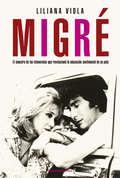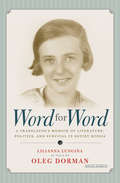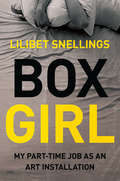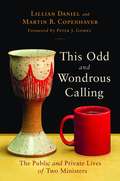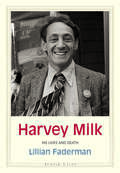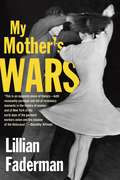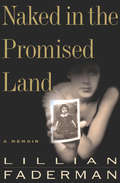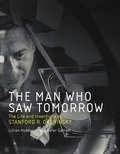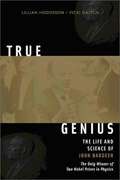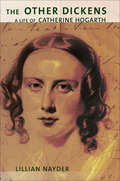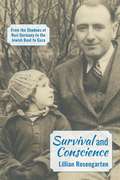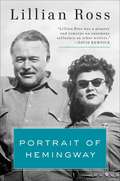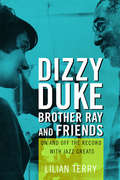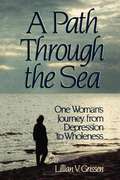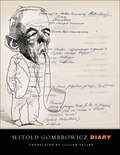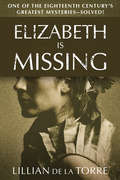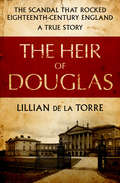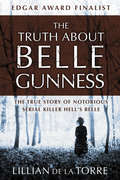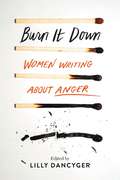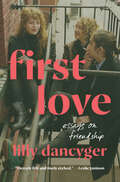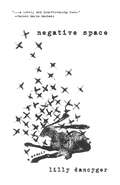- Table View
- List View
Migré: El maestro de las telenovelas que revolucionó la educación sentimental de un país
by Liliana ViolaBiografía del creador de telenovelas célebres como Rolando Rivas, taxista, Piel naranja, Pobre diabla y Una voz en el teléfono, que moldearon la historia sentimental de generaciones de argentinos. Lo llamaron "el señor éxito", "el padre de la lágrima" y "el autor del amor". Escribió más de 700 títulos sin más colaboradores que su máquina Remington. Sus telenovelas fueron una verdadera factoría de galanes, parejas románticas y canciones inolvidables. Durante cuatro décadas tuvo en sus manos las emociones domésticas de las tardes y las noches. Con Rolando Rivas taxista, la ficción más recordada de la televisión argentina, conquistó al público masculino y marcó un nuevo estándar en el modo de producir y mirar tv. Se atrevió a plantear un final infeliz en Piel Naranja en vísperas de la dictadura de 1976 e impuso una palabra guaraní -"rojaiju"- en el lenguaje amoroso de los años 70'. Ultimo representante de la telenovela de autor, Alberto Migré sentó las bases de una industria de los sentimientos que se volvió global. En este libro apasionante Liliana Viola construye una biografía a la medida de su personaje donde cada secreto revelado abre las puertas de un secreto mayor. Actores y actrices, directores, admiradores y amigos íntimos aportan testimonios desopilantes y conmovedores para el retrato del hombre que patentó un modo de amar alternativo a la vida real y supo denunciar como ninguno la influencia nefasta del machismo en las relaciones humanas y el factor melodrama en los rencores que signan la política argentina.
Word for Word: A Translator's Memoir of Literature, Politics, and Survival in Soviet Russia
by Lilianna LunginaA remarkable memoir of living in the Soviet Union and working as a literary translator. In the early twentieth century, Lilianna Lungina was a Russian Jew born to privilege, spending her childhood in Germany, France, and Palestine. But when she was thirteen, her parents moved to the USSR—where Lungina became witness to many of the era&’s greatest upheavals. Exiled during World War II, dragged to KGB headquarters to report on her friends, and subjected to her new country&’s ruthless, systematic anti-Semitism, Lungina nonetheless carved out a career as a translator, introducing hundreds of thousands of Soviet readers to Knut Hamsun, August Strindberg, and, most famously, Astrid Lindgren. In the process, she found herself at the very center of Soviet cultural life, meeting and befriending Pasternak, Brodsky, Solzhenitsyn, and many other major literary figures of the era. Her extraordinary memoir—at once heartfelt and unsentimental—is an unparalleled tribute to a lost world.
Box Girl: My Part-Time Job as an Art Installation
by Lilibet SnellingsWhen 22-year-old Lilibet Snellings moved to Los Angeles on a whim, she unintentionally became a "slash" to keep her head above water-a writer/waitress/actress/Box Girl. One night each week, Lilibet would go to The Standard Hotel in West Hollywood, don a pair of white boy shorts with a matching tank, touch up her lip gloss, and crawl into a giant glass case behind the front desk. There, she could do whatever she wanted-check email, catch up on reading, even sleep-as long as she ignored the many hotel guests who would point and ask the staff, "Is she allowed to use the bathroom?" (Yes.)Dog-paddling through her twenties, Snellings resisted financial bailouts (for the most part) from her sweet Southern mother and business-oriented dad, while pondering her peculiar position as a human art installation. Was she a piece of art or a piece of ass? Was she allowed to read both Walt Whitman and US Weekly as she lounged in an oversized, waterless aquarium behind a hotel concierge desk? From misinterpreting a modeling agency interview as a talent audition, to avoiding Bond-girl-style deaths at New Year's Eve parties, Snellings shares and laughs at her many mishaps while living in LA.
This Odd and Wondrous Calling: The Public and Private Lives of Two Ministers
by Lillian Daniel Martin B. CopenhaverThis Odd and Wondrous Calling offers something different from most books available on ministry. Two people still pastoring reflect honestly here on both the joys and the challenges of their vocation. Anecdotal and extremely readable, the book covers a diversity of subjects revealing the incredible variety of a pastors day. The chapters move from comedy to pathos, story to theology, Scripture to contemporary culture. This Odd and Wondrous Calling is both serious and fun and is ideal for those who are considering the ministry or who want a better understanding of their own ministers life.
Harvey Milk: His Lives and Death (Jewish Lives)
by Lillian FadermanHarvey Milk—eloquent, charismatic, and a smart-aleck—was elected to the San Francisco Board of Supervisors in 1977, but he had not even served a full year in office when he was shot by a homophobic fellow supervisor. Milk’s assassination at the age of forty-eight made him the most famous gay man in modern history; twenty years later Time magazine included him on its list of the hundred most influential individuals of the twentieth century. Before finding his calling as a politician, however, Harvey variously tried being a schoolteacher, a securities analyst on Wall Street, a supporter of Barry Goldwater, a Broadway theater assistant, a bead-wearing hippie, the operator of a camera store and organizer of the local business community in San Francisco. He rejected Judaism as a religion, but he was deeply influenced by the cultural values of his Jewish upbringing and his understanding of anti-Semitism and the Holocaust. His early influences and his many personal and professional experiences finally came together when he decided to run for elective office as the forceful champion of gays, racial minorities, women, working people, the disabled, and senior citizens. In his last five years, he focused all of his tremendous energy on becoming a successful public figure with a distinct political voice.
My Mother's Wars
by Lillian FadermanAn acclaimed writer on her mother's tumultuous life as a Jewish immigrant in 1930s New York and her life-long guilt when the Holocaust claims the family she left behind in Latvia A story of love, war, and life as a Jewish immigrant in the squalid factories and lively dance halls of New York's Garment District in the 1930s, My Mother's Wars is the memoir Lillian Faderman's mother was never able to write. The daughter delves into her mother's past to tell the story of a Latvian girl who left her village for America with dreams of a life on the stage and encountered the realities of her new world: the battles she was forced to fight as a woman, an immigrant worker, and a Jew with family left behind in Hitler's deadly path. The story begins in 1914: Mary, the girl who will become Lillian Faderman's mother, just seventeen and swept up with vague ambitions to be a dancer, travels alone to America, where her half-sister in Brooklyn takes her in. She finds a job in the garment industry and a shop friend who teaches her the thrills of dance halls and the cheap amusements open to working-class girls. This dazzling life leaves Mary distracted and her half-sister and brother-in-law scandalized that she has become a "good-time gal." They kick her out of their home, an event with consequences Mary will regret for the rest of her life. Eighteen years later, still barely scraping by as a garment worker and unmarried at thirty-five, Mary falls madly in love and has a torrid romance with a man who will never marry her, but who will father Lillian Faderman before he disappears from their lives. America is in the midst of the Depression, Hitler is coming to power in Europe, and New York's garment workers are just beginning to unionize. Mary makes tentative steps to join, despite her lover's angry opposition. As National Socialism engulfs Europe, Mary realizes she must find a way to get her family out of Latvia, and she spends frenetic months chasing vague promises and false rumors of hope. Pregnant again, after having submitted to two wrenching back-room abortions, and still unmarried, Mary faces both single motherhood and the devastating possibility of losing her entire Eastern European family. Drawing on family stories and documents, as well as her own tireless research, Lillian Faderman has reconstructed an engrossing and essential chapter in the history of women, of workers, of Jews, and of the Holocaust as immigrants experienced it from American shores.
Naked in the Promised Land: A Memoir
by Lillian FadermanBorn in 1940, Lillian Faderman was the only child of an uneducated and unmarried immigrant Jewish woman. Her mother, whose family perished in the Holocaust, was racked by guilt at having come to America and left them behind; she suffered recurrent psychotic episodes. Her only escape from the brutal labor of her sweatshop job was her fiercely loved daughter, Lilly, whose poignant dream throughout an impoverished childhood was to become a movie star and "rescue" her mother. Lilly grew up to become Lil, outwardly tough, inwardly innocent, hungry for love and success. A beautiful young woman who was learning that her deepest erotic and emotional connections were to women, she found herself in a dangerous but seductive lesbian underworld of addicts, pimps, and prostitutes. Desperately seeking to make her life meaningful and to redeem her mother's suffering, she entered the University of California at Berkeley and worked her way through college as a burlesque stripper. A brilliant student, she ultimately achieved a Ph. D. At last she became Lillian, the woman who in time became a loving partner, a devoted mother, an acclaimed writer, and a charismatic, groundbreaking scholar of gay and lesbian studies. Told with wrenching immediacy and great power, this is an extraordinary memoir: the nakedly honest -- and very American -- story of an exceptional woman and her remarkable, unorthodox life.
Pentimento
by Lillian HellmanLillian Hellman, a renowned playwright, looks back and recounts the people who have affected her life.
The Man Who Saw Tomorrow: The Life and Inventions of Stanford R. Ovshinsky (The\mit Press Ser.)
by Lillian Hoddeson Peter GarrettThe first full-length biography of a brilliant, self-taught inventor whose innovations in information and energy technology continue to shape our world.The Economist called Stanford R. Ovshinsky (1922–2012) “the Edison of our age,” but this apt comparison doesn't capture the full range of his achievements. As an independent, self-educated inventor, Ovshinsky not only created many important devices but also made fundamental discoveries in materials science. This book offers the first full-length biography of a visionary whose energy and information innovations continue to fuel our post-industrial economy.In The Man Who Saw Tomorrow, Lillian Hoddeson and Peter Garrett tell the story of an unconventional genius with no formal education beyond high school who invented, among other things, the rechargeable nickel metal hydride batteries that have powered everything from portable electronics to hybrid cars, a system for mass-producing affordable thin-film solar panels, and rewritable CDs and DVDs. His most important discovery, the Ovshinsky effect, led to a paradigm shift in condensed matter physics and yielded phase-change memory, which is now enabling new advances in microelectronics. A son of the working class who began as a machinist and toolmaker, Ovshinsky focused his work on finding solutions to urgent social problems, and to pursue those goals, he founded Energy Conversion Devices, a unique research and development lab. At the end of his life, battered by personal and professional losses, Ovshinsky nevertheless kept working to combat global warming by making solar energy “cheaper than coal”—another of his many visions of a better tomorrow.
True Genius: The Life And Science Of John Bardeen
by Lillian Hoddeson Vicki DaitchWhat is genius? Define it. Now think of scientists who embody the concept of genius. Does the name John Bardeen spring to mind? Indeed, have you ever heard of him?Like so much in modern life, immediate name recognition often rests on a cult of personality. We know Einstein, for example, not just for his tremendous contributions to science, but also because he was a character, who loved to mug for the camera. And our continuing fascination with Richard Feynman is not exclusively based on his body of work; it is in large measure tied to his flamboyant nature and offbeat sense of humor.These men, and their outsize personalities, have come to erroneously symbolize the true nature of genius and creativity. We picture them born brilliant, instantly larger than life. But is that an accurate picture of genius? What of others who are equal in stature to these icons of science, but whom history has awarded only a nod because they did not readily engage the public? Could a person qualify as a bona fide genius if he was a regular Joe?The answer may rest in the story of John Bardeen.John Bardeen was the first person to have been awarded two Nobel Prizes in the same field. He shared one with William Shockley and Walter Brattain for the invention of the transistor. But it was the charismatic Shockley who garnered all the attention, primarily for his Hollywood ways and notorious views on race and intelligence.Bardeen’s second Nobel Prize was awarded for the development of a theory of superconductivity, a feat that had eluded the best efforts of leading theorists—including Albert Einstein, Neils Bohr, Werner Heisenberg, and Richard Feynman. Arguably, Bardeen’s work changed the world in more ways than that of any other scientific genius of his time. Yet while every school child knows of Einstein, few people have heard of John Bardeen. Why is this the case?Perhaps because Bardeen differs radically from the popular stereotype of genius. He was a modest, mumbling Midwesterner, an ordinary person who worked hard and had a knack for physics and mathematics. He liked to picnic with his family, collaborate quietly with colleagues, or play a round of golf. None of that was newsworthy, so the media, and consequently the public, ignored him.John Bardeen simply fits a new profile of genius. Through an exploration of his science as well as his life, a fresh and thoroughly engaging portrait of genius and the nature of creativity emerges. This perspective will have readers looking anew at what it truly means to be a genius.
The Other Dickens
by Lillian NayderCatherine Hogarth married Charles Dickens in 1836, the same year he began serializing his first novel. After 18 years of marriage and 10 children, he pressured her into leaving their home in order to pursue another woman, claiming that she was 'mentally disordered. ' This biography gives details on Catherine Hogarth's family of origin as well as her family of marriage and shows that she was not 'mentally disordered. ' Nayder, professor and chair of English at Bates College, offers insights into the relationships among the four Hogarth sisters and examines the legal and emotional ambiguities of Catherine's position as a 'single wife' in the Victorian age. The book includes b&w historical illustrations. Annotation ©2011 Book News, Inc. , Portland, OR (booknews. com)
Survival and Conscience: From the Shadows of Nazi Germany to the Jewish Boat to Gaza
by Mark Braverman Lillian RosengartenIn 1936, Lillian Rosengarten and her family fled Nazi Germany for New York. But even there, the legacy of the Nazis' brutality continued to cast a shadow over her family for many decades. In Survival and Conscience, Rosengarten describes how she faced those challenges within her own life while gaining empathy for the struggles of others, realizing that all forms of extreme nationalism and hatred must be vigorously resisted. Like many other refugees from Nazism and survivors of the Holocaust, Rosengarten became a strong advocate of Palestinian rights. In 2010, she joined the "Jewish Boat to Gaza," designed to break Israel's punishing blockade of the Gaza Strip. Though the Israeli Navy obstructed their humanitarian mission, nothing can stop Lillian Rosengarten's inspiring story of love, self-discovery, and activism.
Portrait of Hemingway (Modern Library Anthologies Ser.)
by Lillian RossThe definitive sketch of one of America's greatest writers.On May 13, 1950, Lillian Ross's first portrait of Ernest Hemingway was published in The New Yorker. It was an account of two days Hemingway spent in New York in 1949 on his way from Havana to Europe. This candid and affectionate profile was tremendously controversial at the time, to the great surprise of its author. Booklist said, "The piece immediately conveys to the reader the kind of man Hemingway was--hard-hitting, warm, and exuberantly alive." It remains the classic eyewitness account of the legendary writer, and it is reproduced here with the preface Lillian Ross prepared for an edition of Portrait in 1961. Ernest Hemingway was born on July 21, 1899, and to celebrate the centenary of this event, Ms. Ross wrote a second portrait of Hemingway for The New Yorker, detailing the friendship the two struck up after the completion of the first piece. It is included here in an amended form.
Dizzy, Duke, Brother Ray, and Friends: On and Off the Record with Jazz Greats
by Lillian TerryLilian Terry has lived music. As a performer, she has shared the stage with Ella Fitzgerald and Nina Simone. She cofounded the European Jazz Federation and pioneered jazz education in Italy. Her work as a director-producer of radio and television programs have spread the music by introducing countless people to its legendary performers. Drawing on Terry's long friendships and professional associations, Dizzy, Duke, Brother Ray, and Friends offers readers a rare opportunity to hear intimate conversations with some of the world's greatest musical figures. Dizzy Gillespie offers his thoughts on playing with œsanctified rhythm and the all-important personal touch in performance. Duke Ellington discourses on jazz history and concludes an interview to sing a self-written ditty in Italian. Ray Charles gives candid thoughts on race and politics while taking charge of Terry's tape recorder. Abbey Lincoln, Max Roach, Horace Silver, Bill Evans ”all provide Terry and her readers with unforgettable encounters. The result is a collection of profiles, some stretching over a decade or more, that reveal these performers in ways that illuminates their humanity and expands our appreciation of their art.
A Path Through the Sea: One Woman's Journey from Depression to Wholeness
by Lillian V. GrissenIn this frank, instructive, and heartening personal story, Lillian Grissen tells about the severe depression that she herself experienced. Her pain - mental, emotional, and physical pain - was excruciating, and at first she felt hopelessly trapped in it. But with the help of a gifted Christian psychiatrist, Grissen began to stop blaming herself and to confront the core of her problem - her relationship as a child with her mother. Over a period of five long years - also with her husband's support, her pastor's compassionate counsel, and the right combination of therapy and medication, and God's gracious strength - Grissen gradually climbed out of the pit of her depression. A profound yet simple book about a complex condition: clinical depression. Only one who has experienced the pain of the darkness of depression and the joy of the light of recovery could have had the courage to trace the arduous journey. - Katie Funk Wiebe, author of Bless Me Too, My Father
Diary
by Lillian ValleeJust before the outbreak of World War II, young Witold Gombrowicz left his home in Poland and set sail for South America. In 1953, still living as an expatriate in Argentina, he began hisDiarywith one of literature's most memorable openings: "Monday Me. Tuesday Me. Wednesday Me. Thursday Me. " Gombrowicz'sDiarygrew to become a vast collection of essays, short notes, polemics, and confessions on myriad subjects ranging from political events to literature to the certainty of death. Not a traditional journal,Diaryis instead the commentary of a brilliant and restless mind. Widely regarded as a masterpiece, this brilliant work compelled Gombrowicz's attention for a decade and a half until he penned his final entry in France, shortly before his death in 1969. Long out of print in English,Diaryis now presented in a convenient single volume featuring a new preface by Rita Gombrowicz, the author's widow and literary executor. This edition also includes ten previously unpublished pages from the 1969 portion of the diary.
Elizabeth Is Missing: One of the Eighteenth Century's Greatest Mysteries—Solved!
by Lillian de la TorreThe true story of the eighteenth-century English maidservant at the center of a fascinating criminal mystery. On New Year&’s Day, 1753, Elizabeth Canning disappeared. An eighteen-year-old girl, she was unremarkable in every respect, from her appearance to her disposition, but she was about to become the most famous person in London. When she reappeared one month later, starving and ill, she claimed she had been abducted and held captive by a woman named Susannah Wells, who wanted Elizabeth to work for her as a prostitute. Based on Elizabeth&’s testimony, Wells was arrested, tried, and convicted—but the case was just getting started. Convinced the young woman was lying, the Lord Mayor of London set out to uncover the truth. What followed was one of the most celebrated criminal cases of the era. The controversy, which threatened to tear London apart, revolved around one frightened, mysterious girl. Meticulously researched and irresistibly readable, Elizabeth Is Missing is the definitive account of one of the most unusual cases of the eighteenth century, a must-read for fans of historical true crime.
The Heir of Douglas: The Scandal That Rocked Eighteenth-Century England
by Lillian de la TorreA sensational account of the Lady Jane Douglas scandal: A penniless Frenchman claimed a title and turned eighteenth-century England upside down. In 1748, Scottish noblewoman Lady Jane Douglas gave birth to twin boys in Paris. Although she and one of the boys died in poverty five years later, her surviving son was heir to one of the greatest fortunes in England, and would become one of the most important men in the empire—if his inheritance were secure. But was Archibald Douglas really Lady Jane&’s son? His mother was fifty at the time of his birth—an incredible circumstance in any century—and if it could be proven that Archibald was adopted, the fortune would pass to another. The Douglas Cause, one of the greatest scandals in English history, a legal case whose twists and turns mesmerized the British public, led the citizens of Edinburgh to riot, and threatened to undermine the very fabric of the empire. Based on six years of research, The Heir of Douglas is the thrilling, definitive account of an astonishing court case, written by a woman who &“knows her way about in the eighteenth century&” (The New York Times).
The Truth about Belle Gunness: The True Story of Notorious Serial Killer Hell's Belle
by Lillian de la TorreEdgar Award Finalist: The true story of the female Norwegian immigrant who led a secret life as a serial killer in the early twentieth-century Midwest. On the morning of April 27, 1908, the farmhand on a lonely property outside La Porte, Indiana, woke to the smell of smoke. He tried to rouse the lady of the house, the towering Belle Poulsdatter Sorenson Gunness, and he called the names of her three children—but they didn&’t answer, and the farmhand barely escaped alive. The house burned to the foundation, and in the rubble, firemen found the corpses of Belle, her two daughters, and her son. The discovery raised two chilling questions: Who started the fire, and who cut off Belle&’s head? As investigators searched the property, they uncovered something astonishing: The remains of a dozen or more men and children who had been murdered with poison or cleaver were buried beneath the hog pen. It turned out Belle Gunness was one of the most prolific serial killers in American history. And when the investigation revealed that the body found in the fire might not have been hers, the people of La Porte were forced to confront the terrifying realization that Belle might have gotten out alive. Nominated for an Edgar Award for best factual crime story, The Truth about Belle Gunness is based on extensive interviews with witnesses and residents of La Porte who knew Belle and her family. Perfect for fans of In Cold Blood or The Devil in the White City, it is a &“magnificent [and] brilliantly written&” exploration of a highly unusual murderer (The New York Times).
The White Light of Grace: Reflections On The Life Of A Spiritual Intuitive
by Lillie LeonardiEver since she was a little girl, Lillie Leonardi could hear the whispers of angels. No one else could hear or see them, but deep down she knew they were real, and that they would help guide and protect her. She spent years pushing these visions aside, but on September 11, 2001, her life, like so many others, was forever changed. After witnessing a legion of angels at the Flight 93 crash site, she experienced an incredible transformation that opened her up to the magic, mystery, and miracles of life. And she gained the courage to share her story with others . . .In this decades-spanning memoir, Lillie reveals how she first uncovered her intuitive gifts. She explains how her ancestry, her strict Catholic upbringing, and other significant events impacted her spiritual evolution and faith in God. From understanding love and marriage, becoming a mother, and finding her true purpose and vocation in law enforcement to confronting separation, death, and loss, Lillie describes times in her life when she called on the angels for blessings, and others when she learned how to rely on herself. Throughout her journey of self-discovery, her realizations about forgiveness, self-acceptance, and healing unfold and offer divine inspiration for readers.
Frederick Douglass: Freedom Fighter
by Lillie PattersonDouglass fought for the rights of all people and of animals. He was an accomplished orator.
Martin Luther King, Jr.: Man of Peace
by Lillie Patterson Victor MaysA brief biography of Martin Luther King Jr, that helps the readers understand what it entails to have a fulfilling and successful life.<P><P>Winner of the Coretta Scott King Medal
Burn It Down: Women Writing about Anger
by Lilly Dancygerp.p1 {margin: 0.0px 0.0px 0.0px 0.0px; font: 12.0px 'Times New Roman'} p.p2 {margin: 0.0px 0.0px 0.0px 0.0px; font: 12.0px 'Times New Roman'; min-height: 15.0px} A rich, nuanced exploration of women's anger from a diverse group of writers Women are furious, and we're not keeping it to ourselves any longer. We're expected to be composed and compliant, but in a world that would strip us of our rights, disparage our contributions, and deny us a seat at the table of authority, we're no longer willing to quietly seethe behind tight smiles. We're ready to burn it all down. In this ferocious collection of essays, twenty-two writers explore how anger has shaped their lives: author of the New York Times bestseller The Empathy Exams Leslie Jamison confesses that she used to insist she wasn't angry-until she learned that she was; Melissa Febos, author of the Lambda Literary Award-winning memoir Abandon Me, writes about how she discovered that anger can be an instrument of power; editor-in-chief of Bitch Media Evette Dionne dismantles the "angry Black woman" stereotype; and more. Broad-ranging and cathartic, Burn It Down is essential reading for any woman who has scorched with rage-and is ready to claim her right to express it.
First Love: Essays on Friendship
by Lilly DancygerA bold, poignant essay collection that treats women&’s friendships as the love stories they truly are, from the critically acclaimed author of Negative Space&“Fiercely felt and finely etched.&”—Leslie Jamison, New York Times bestselling author of The Empathy ExamsLilly Dancyger always thought of her closest friendships as great loves, complex and profound as any romance. When her beloved cousin was murdered just as both girls were entering adulthood, Dancyger&’s devotion to the women in her life took on a new urgency—a desire to hold her friends close while she still could. In First Love, this urgency runs through a striking exploration of the bonds between women, from the intensity of adolescent best friendship and fluid sexuality to mothering and chosen family.Each essay in this incisive collection is grounded in a close female friendship in Dancyger&’s life, reaching outward to dissect cultural assumptions about identity and desire, and the many ways women create space for each other in a world that wants us small. Seamlessly weaving personal experience with literature and pop culture—ranging from fairy tales to true crime, from Anaïs Nin and Sylvia Plath to Heavenly Creatures and the &“sad girls&” of Tumblr—Dancyger&’s essays form a kaleidoscopic story of a life told through friendships, and an expansive interrogation of what it means to love each other.Though friendship will never be enough to keep us safe from the dangers of the world, Dancyger reminds us that love is always worth the risk, and that when tragedy strikes, it&’s our friends who will help us survive. In First Love, these essential bonds get their due.
Negative Space (SFWP Literary Awards)
by Lilly DancygerDespite her parents' struggles with addiction, Lilly Dancyger always thought of her childhood as a happy one. But what happens when a journalist interrogates her own rosy memories to reveal the instability around the edges? Dancyger's father, Joe Schactman, was part of the iconic 1980s East Village art scene. He created provocative sculptures out of found materials like animal bones, human hair, and broken glass, and brought his young daughter into his gritty, iconoclastic world. She idolized him—despite the escalating heroin addiction that sometimes overshadowed his creative passion. When Schactman died suddenly, just as Dancyger was entering adolescence, she went into her own self-destructive spiral, raging against a world that had taken her father away. As an adult, Dancyger began to question the mythology she'd created about her father—the brilliant artist, struck down in his prime. Using his sculptures, paintings, and prints as a guide, Dancyger sought out the characters from his world who could help her decode the language of her father's work to find the truth of who he really was.
